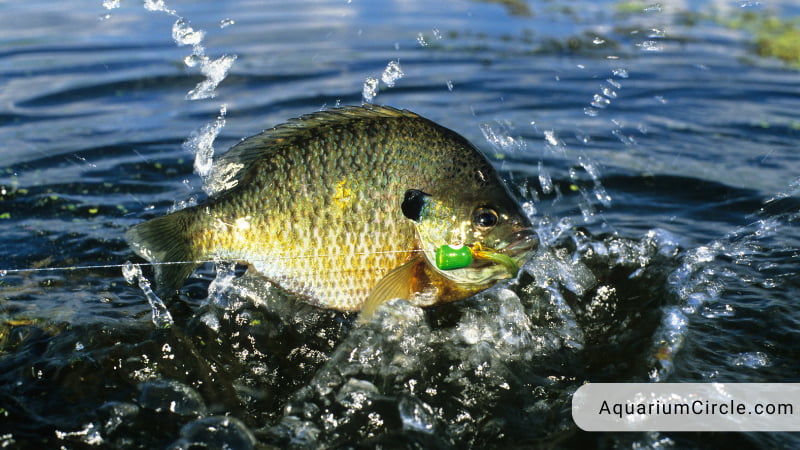“What Do Bluegill Eat?” is a common question asked by anglers as well as aquarium enthusiasts and private pond owners those interested in the ecology of freshwater ecosystems. Bluegill, a popular freshwater fish species found in North America, have a varied diet that consists of both animal and plant matter. Understanding what bluegill eat and their feeding habits is essential for successful fishing and managing aquatic habitats.
In this blog post, we’ll explore the diet of bluegill, their feeding habits, and some tips for catching them. So, let’s dive in and learn more about what do bluegill eat!
See also:
- How Often Do You Feed Guppy Fish? – Best Food For Guppy
- What Do Nassarius Snails Eat? (care Guide)
- Do Molly Fish Eat Their Babies? (how To Protect The Fries)
What Do Bluegill Eat In Their Natural Environment?
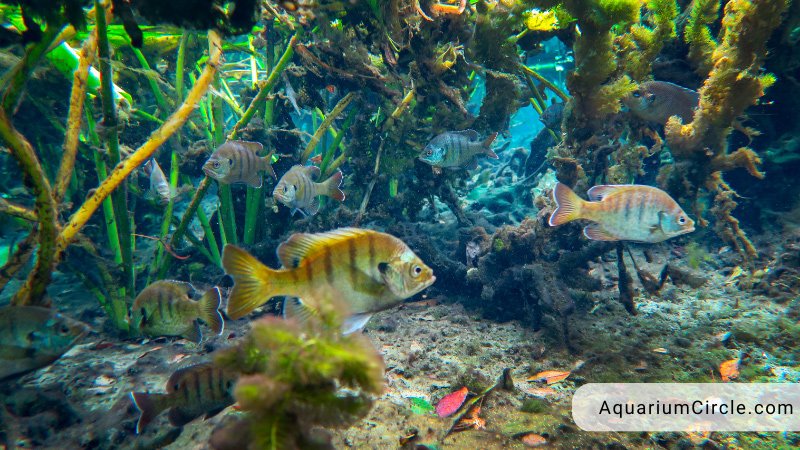
In their natural environment such as lake or pond, bluegill can eat a wide variety of food sources. Their diet primarily consists of insects and their larvae, crustaceans, small fish and their fry, and aquatic plants and algae. Bluegill are opportunistic feeders, which means they will eat whatever is available and fits in their mouth. They are particularly fond of aquatic insects such as mayflies, caddisflies, and dragonflies, and will also consume small fish, including their own young.
In addition to animal matter, bluegill will consume a variety of aquatic plants and algae, particularly during the spring and summer months. Their diet can vary seasonally, with bluegill feeding more heavily on insects during the warmer months and switching to a diet of algae and plant matter during the fall and winter. We will discuss about this variety when you keep reading.
What Do Bluegills Eat In The Captivity?
Bluegill can consume both traditional food sources and commercially available fish foods in captive environments such as aquariums. If you prefer to feed your Bluegills with minnows, grass shrimp, crickets, or mealworms, they will readily eat them. Additionally, there are many commercial options available if you prefer to feed your bluegill a specialized diet.
You can easily find “Bluegill fish food” by doing a quick search online, and popular brands like AquaMax, Purina, and AquaNourish are commonly used. These products provide a simple and convenient alternative for feeding Bluegill and other sunfish in garden ponds or aquariums. Some people even opt to feed their bluegill with hot dogs or leftover lunchmeat, which can also be an option.
What Food Do Baby Bluegill Eat?
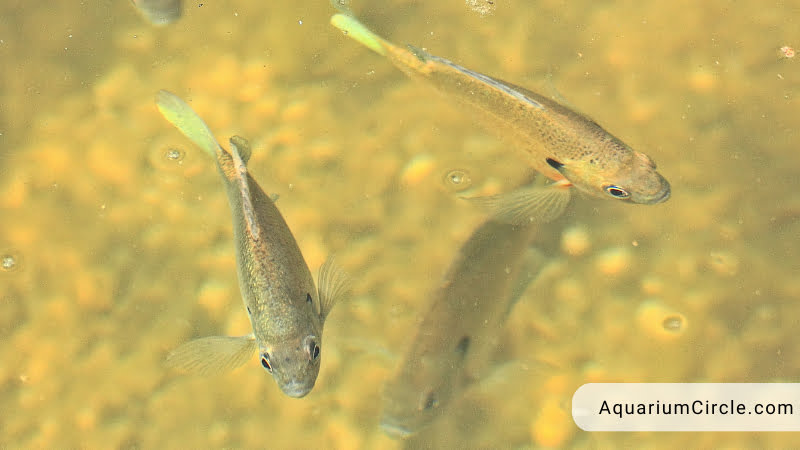
When the water temperatures reach 69 degrees Fahrenheit each summer, Bluegill begin to spawn. In shallow water, hundreds of thousands of baby bluegill hatch from eggs and are known as fry. These fry grow rapidly and are quite voracious, constantly searching for food. Bluegill feed on zooplankton primarily, which are microscopic organisms that play a critical role in maintaining the health of freshwater ecosystems.
The two most common groups of zooplankton are Cladocera and Copepods. As Bluegill grow to about 1-2 inches in length, they begin to shift their diet to more visible food sources, such as dragonfly larvae, mosquitofish, insects, and freshwater shrimp.
Bluegill Fish Diet Change Bases On Season
Seasonal changes play an important role in the diet of Bluegill. During the spring and summer months, when water temperatures are warmer, Bluegill feed more actively on insects and their larvae. They also consume a variety of aquatic plants and algae during this time. As the water temperature cools down during the fall and winter months, Bluegill’s diet shifts towards crustaceans and small fish, including their own young. They are less likely to feed on insects and plants during this time.
It’s important to keep these seasonal changes in mind when planning a fishing trip for Bluegill. In the warmer months, using insect imitations such as flies or poppers can be particularly effective. In contrast, during the colder months, using small jigs, spinners, or live bait like worms or minnows can be more effective. Knowing the seasonal changes in Bluegill’s diet can help anglers make informed decisions on what bait to use and when to use it, resulting in a more successful fishing trip.
What If There Are Too Many Bluegill In The Pond?
If there are too many Bluegill in a pond, it can lead to stunted growth, a decrease in the overall health of the fish population, and an imbalance in the aquatic ecosystem. It’s important to address the issue to prevent negative impacts on the pond and its inhabitants.
One solution is to remove some of the Bluegill from the pond through fishing. Anglers can keep a certain number of fish per day according to local regulations, and this can help reduce the population. Another option is to introduce natural predators such as bass or catfish to the pond. These predators can help control the Bluegill population by preying on them.
It’s also important to ensure that the pond has sufficient habitat and food sources for the remaining Bluegill population. A balanced ecosystem with a variety of aquatic plants and invertebrates can help support a healthy fish population.
Are There Any Animals Eat Bluegill?
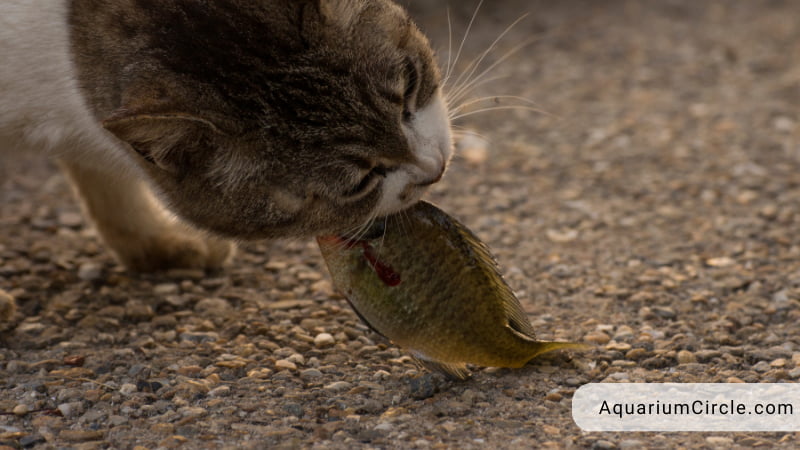
In their natural environment, Bluegill are susceptible to predation from a variety of animals. Large predator fish such as largemouth bass, trout, and northern pike can prey on Bluegill due to their relatively small size. Additionally, turtles have been known to consume Bluegill as part of their diet. Bluegill are also targeted by birds like herons and kingfishers that feed on them from above the water surface.
Mammals are also known to eat Bluegill. Otters have been observed as Bluegill predators, and raccoons are also believed to be capable of catching Bluegill for food. Overall, Bluegill are an important part of the food chain in freshwater ecosystems and are preyed upon by a diverse range of animals both in and out of the water.
Can Humans Eat Bluegill?
Yes, humans can eat Bluegill. In fact, Bluegill is a popular game fish in North America, and many people enjoy eating them. The meat is generally considered to be mild-tasting and white, with a firm texture. Bluegill can be cooked using a variety of methods, such as pan-frying, grilling, or baking. Many anglers consider Bluegill to be an excellent eating fish, and it is often cooked and served whole, with the skin on. However, it’s important to ensure that the fish is properly cleaned and cooked to avoid any foodborne illnesses. Additionally, it’s always important to follow local fishing regulations and guidelines when harvesting fish for consumption.
What Is The Best Bait For Bluegill?
Anglers often hold a special place in their hearts for Bluegill due to their propensity for biting on a variety of baits and their surprisingly relaxed demeanor around humans. In fact, some Bluegill populations, such as those in Lake Scugog, Canada, have become so accustomed to humans that they allow tourists to “pet” them!
Live bait options like worms, crickets, grasshoppers, flies, maggots, small frogs, or minnows can be used to attract Bluegill to your line. Additionally, table scraps like bread or corn may work as well. Artificial baits and lures such as fake worms, spinners, crankbaits, and poppers have been known to work effectively. As sight feeders, Bluegill are often drawn to vibrant colors like orange, yellow, green, or bright red.
It’s important to remember that Bluegill are warm-water fish species and feed most actively in temperate weather. During cooler months, many Bluegill will not bite or go for live bait at all. In such cases, reducing bait size may help, with mini grubs such as wax worms being popular among ice fishermen due to their ability to coax even winter Bluegill into biting.
Tips For Catching Bluegill Based On Their Feeding Habits
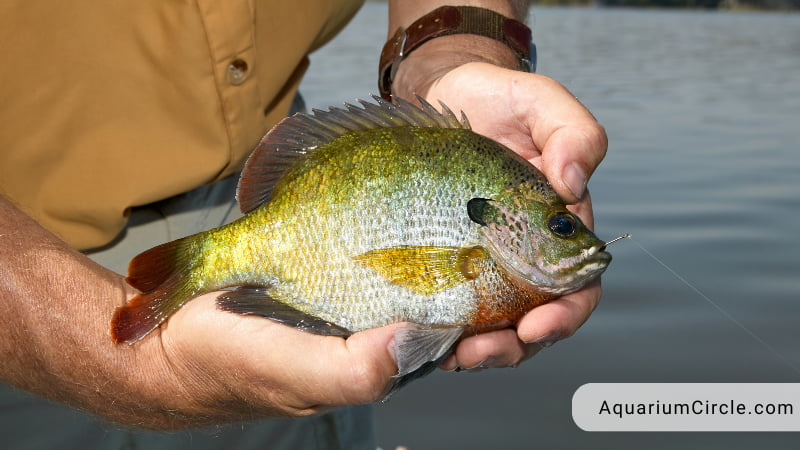
Here are some tips for catching Bluegill based on their feeding habits:
- Use small baits: Bluegill have small mouths, so using small baits like worms, crickets, or small jigs can be very effective.
- Fish during the morning and late afternoon: Bluegill are most active and feed during the morning and late afternoon hours. This is a good time to fish for them.
- Fish in shallow water: Bluegill tend to feed in shallow water, particularly in the spring and summer months when they are feeding on insects and their larvae.
- Use insect imitations: Bluegill feed heavily on insects during the warmer months, so using insect imitations such as flies, poppers, or small lures can be very effective.
- Try different depths: Bluegill can be found at a range of depths, so trying different depths with your bait or lure can help you find where the fish are feeding.
- Look for structure: Bluegill often congregate around structure like weed beds, logs, or rocks, so targeting these areas can be effective.
- Change up your bait: If Bluegill aren’t biting on one type of bait or lure, try switching to another. Experimenting with different baits can help you find what the fish are feeding on that day.
By understanding Bluegill’s feeding habits and adapting your fishing approach accordingly, you can increase your chances of catching these popular game fish.
Is It Possible To Keep A Bluegill As A Pet?
Of course it is possible to keep Bluegill as pets, although it is not a common practice. Bluegill can be kept in aquariums or outdoor ponds, but there are several factors to consider before doing so.
Firstly, Bluegill require a large amount of space to swim and thrive. In an aquarium, a minimum of 50 gallons of water per fish is recommended, with a depth of at least 2 feet. In an outdoor pond, the pond should be at least 1/4 acre in size.
Secondly, Bluegill are omnivorous and require a varied diet consisting of both animal and plant matter. A diet of commercial fish food pellets supplemented with live or frozen food like bloodworms, brine shrimp, or insects is recommended.
Thirdly, Bluegill are social animals and should be kept in groups of at least 6-8 individuals. Mixing Bluegill with other fish species in an aquarium or pond is possible, but it’s important to ensure that the other fish are compatible with Bluegill and can tolerate the same water conditions.
Overall, while it is possible to keep Bluegill as pets, it requires a large amount of space and effort to create an appropriate living environment and provide a suitable diet. It’s important to do research and ensure that you can provide a suitable home for Bluegill before considering them as a pet.
Video About What Do Bluegill Eat
FAQs
What is the primary food source for bluegill?
The primary food sources for bluegill are insects and their larvae, crustaceans, small fish and their fry, and aquatic plants and algae.
Do bluegill have a preferred food?
Bluegill do not have a preferred food, but their diet varies based on the availability of food sources in their habitat.
What time of day do bluegill feed?
Bluegill are most active and feed during early morning and late afternoon, but they may also feed throughout the day.
Can bluegill be caught using artificial lures?
Yes, bluegill can be caught using a variety of artificial lures such as small jigs, spinners, and poppers.
How do weather conditions affect bluegill feeding habits?
Weather conditions such as temperature, wind, and precipitation can affect the feeding habits of bluegill. For example, they may feed more actively in warmer water temperatures and during calm, overcast conditions.
References

Annette M. Chaney is an experienced marine biologist with over 20 years of experience as an aquarist and fishkeeper. She started her first aquarium at a young age, filling it with frogs and goldfish obtained from the ten-cent pet store.
Annette grew up caring for and breeding African Cichlids, which led to a hobby in high school that doubled as a profitable means. Attending Reed College gave her time to solidify herself as an accomplished aquarium caretaker with an eye for sales. After that, from 2009 – 2013, she studied at Roger Williams University – one of the most prestigious universities for Aquaculture and Aquarium in USA. She is the founder of AquariumCircle since 2010.
